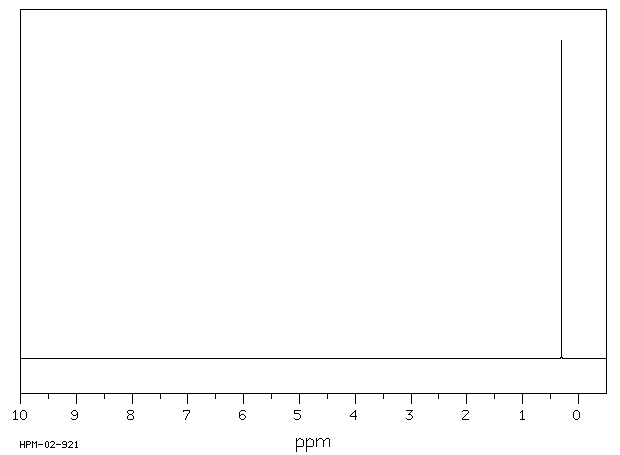二(三甲基锗烷基)氧化物 | 2237-93-6
中文名称
二(三甲基锗烷基)氧化物
中文别名
——
英文名称
hexamethyldigermoxane
英文别名
Hexamethyldigermoxan;trimethyl(trimethylgermyloxy)germane
CAS
2237-93-6
化学式
C6H18Ge2O
mdl
——
分子量
251.388
InChiKey
VZCOEYJEFYGNBM-UHFFFAOYSA-N
BEILSTEIN
——
EINECS
——
-
物化性质
-
计算性质
-
ADMET
-
安全信息
-
SDS
-
制备方法与用途
-
上下游信息
-
文献信息
-
表征谱图
-
同类化合物
-
相关功能分类
-
相关结构分类
物化性质
-
熔点:-61.1 °C
-
沸点:137 °C(Press: 730 Torr)
-
密度:1.2086 g/cm3(Temp: 21.5 °C)
计算性质
-
辛醇/水分配系数(LogP):2.67
-
重原子数:9
-
可旋转键数:2
-
环数:0.0
-
sp3杂化的碳原子比例:1.0
-
拓扑面积:9.2
-
氢给体数:0
-
氢受体数:1
SDS
反应信息
-
作为反应物:描述:二(三甲基锗烷基)氧化物 、 三丁基氧化锡 以71%的产率得到Tributylstannyl trimethylgermyl ether参考文献:名称:Mehrotra, S. K.; Srivastava, G.; Mehrotra, R. C., Indian journal of chemistry, 1974, vol. 12, p. 629 - 630摘要:DOI:
-
作为产物:描述:参考文献:名称:FT-IR Study of the Gas-Phase Autoxidation of Trimethylgermane摘要:The kinetics and mechanism of the autoxidation of trimethylgermane in the gas phase has been investigated in the temperature range 493-533 K using Fourier transform infrared spectroscopy. Over a wide molar ratio of reactants (Me3GeH:O2 ratio in the range (1:1)-(1:31)) the loss of Me3GeH follows second-order kinetics but is independent of oxygen abundance. The products of the reaction are heyamethyldigermoxane, Me3GeOGeMe3, and water. No other products are apparent. For a 1:10 Me3GeH:02 molar ratio, second-order rate constants vary from 2.46 mol-1 de s-1 at 493 K to 64.1 mol-1 dm3 s-1 at 533 K. The activation energy for the process -is determined to be 190 +/- 19 kJ mol-1. The proposed mechanism involves an initial abstraction of the hydridic hydrogen atom from germanium followed by the reaction of the trimethylgermyl radical thus formed with oxygen, giving the (trimethylgermyl)peroxyl radical. This radical is converted into trimethylgermyl hydroperoxide, Me3GeOOH, by further H-abstraction from Me3GeH and undergoes O-O bond fission to form (trimethylgermyl)oxyl and hydroxyl radicals. The radicals thus produced propagate the reaction by H-abstraction from Me3GeH, forming the intermediate Me3GeOH and water. Hexamethyldigermoxane is subsequently formed by self-condensation of two Me3GeOH molecules.DOI:10.1021/om00017a012
-
作为试剂:描述:叠氮基三甲基硅烷 在 二(三甲基锗烷基)氧化物 作用下, 以 氘代氯仿 为溶剂, 反应 0.17h, 生成 alkaline earth salt of/the/ methylsulfuric acid参考文献:名称:叠氮化三甲基甲硅烷基与六甲基二氧杂戊烷之间的交换反应摘要:三甲基硅烷基叠氮化物和六甲基二甲基氧烷在室温下进行交换,以化学计量产生三甲基(三甲基硅氧基)锗烷和三甲基锗烷基叠氮化物。已在21到53°C之间的几个温度下测量了该二级反应的速率。此数据的Arrhenius曲线给出了以下激活参数:ΔS ‡ = −40±2 eu。活化的大负熵意味着该反应具有高度有序的过渡态。DOI:10.1016/0022-328x(88)83002-x
文献信息
-
Metal-Mediated Production of Isocyanates, R<sub>3</sub>ENCO from Dinitrogen, Carbon Dioxide, and R<sub>3</sub>ECl作者:Andrew J. Keane、Wesley S. Farrell、Brendan L. Yonke、Peter Y. Zavalij、Lawrence R. SitaDOI:10.1002/anie.201502293日期:2015.8.24A highly efficient and versatile chemical cycle has been developed for the production of isocyanates through the molecular fixation of N2, CO2 and R3ECl (E=C, Si, and Ge). Key steps include a ‘one‐pot’ photolytic NN bond cleavage of a Group 6 dinuclear dinitrogen complex with in situ trapping by R3ECl to provide a metal terminal imido complex that can engage in simultaneous nitrene‐group transfer
-
Characterisation of bis-methylgermanium and bis-methylsilicon carbodi-imides and their reactivity with protic reagents作者:John E. Drake、Raymond T. Hemmings、Ernest HendersonDOI:10.1039/dt9760000366日期:——bismethylsilicon carbodi-imides have been prepared in high yield by halide metathesis reactions with lead(II), silver(I), or silicon(IV) species. The new derivatives in the series of general formula (MenH3 –nMN:)2C (MSi or Ge; n= 1, 2 or 3) have been characterised by 1H n.m.r., i.r., and Raman spectroscopy as well as mass spectrometry and cleavage reactions. The utility of the germanium carbodi-imides as synthetic
-
Photochemical reactions of 2-(pentamethyldisilanyl)furan and 2-(pentamethyldigermanyl)furan. Formation of a radical pair作者:Kunio Mochida、Kohichi Kimijima、Masanobu Wakasa、Hisaharu HayashiDOI:10.1016/0022-328x(94)87043-8日期:1994.2Photochemical reactions of 2-(pentamethyldisilanyl)furan and 2-(pentamethyldigermanyl)furan have been investigated by chemical trapping experiments and laser flash-photolysis. On irradiation, the furylated catenates of Group 14 elements undergo silicon-silicon σ bond and germanium-germanium σ bond homolysis to give a pair of silyl radicals and germyl radicals, respectively. In CCl4, these radicals
-
Gmelin Handbuch der Anorganischen Chemie, Gmelin Handbook: S: SVol.4a/b, 1.3.12, page 303 - 305作者:DOI:——日期:——
-
Gmelin Handbuch der Anorganischen Chemie, Gmelin Handbook: Sn: Org.Comp.12, 1.4.1.1.1.5.15, page 220 - 223作者:DOI:——日期:——
表征谱图
-
氢谱1HNMR
-
质谱MS
-
碳谱13CNMR
-
红外IR
-
拉曼Raman
-
峰位数据
-
峰位匹配
-
表征信息
同类化合物
黄原酸环癸酯
高纯三甲基锑
顺式-二氯二(环丙胺)铂(II)
顺式-二氯二(乙二胺)氯化铑(1+)
顺式-二(环己基丁氨合)二氯铂(II)
顺式-二(异丙基氨合)二氯铂(II)
顺式-(2-氨基甲基-1-环戊基氨合)二氯铂(II)
顺二氯二羰基铂(II)
顺-二氯双(乙二胺)氯化铱
雷(酸)汞[含水或水加乙醇≥20]
间碳硼烷-9-硫醇
镍,加合(7:2)钪
镉二(二戊基二硫代氨基甲酸盐)
镁,溴-6-庚烯基-
manganese carbide
butyl manganese bromide
锡烷,氯二环己基-
锡四丁醇
锑,(1:1)混合物和钪
锌叔-丁氧化物
锌,溴-1-丙烯基-,(E)-
锇,加合(2:1)钪
锆酸四丁酯
锂丁酯
锂4-异丙氧基-2-甲基-丁烷-2-醇
锂1-丁醇
锂(三氟甲基)乙炔化物
锂(3-氨基丙基)酰胺
铼五羰基碘化物
铼五羰基
银(I)2-羟基乙烷-1-硫醇盐
铯三氯三羰基锇
铬三乙二胺
铬,五羰基(环己胺)-,(OC-6-22)-
铬,二(乙酰腈)二氯-
铝,加合(3:1)钪
铜-乙二胺络合物
铜(II)乙二胺
铜(I)乙炔化物
铍,环戊-1,3-二烯,溴化
铊N,N-二正丁胺
铊,甲氧基二甲基-
铂(2+)二氯化3-甲基丁烷-1,2-二胺(1:1)
铁(3+)三(1-丁醇)
铁(2+)1,1'-(硫烷二基二-1,1-乙二基)二-2,4-环戊二烯化
铀,三甲基-
钾,[三(三甲基甲硅烷基)甲基]-
钴四异硫氰酸酯
钴,乙烷-1,2-二胺
钠辛基二硫代氨基甲酸酯







